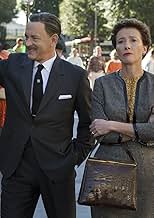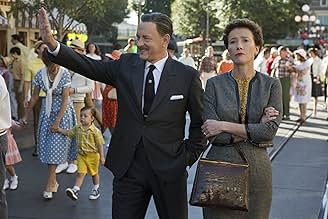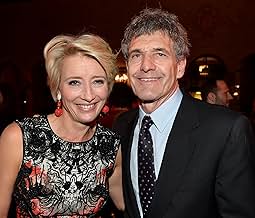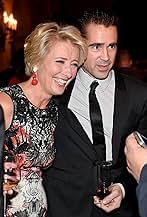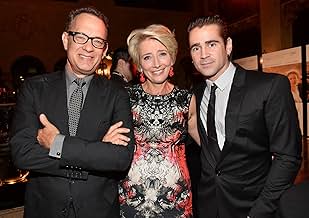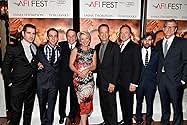La scrittrice P.L. Travers acconsente di incontrare Walt Disney, che desidera adattare il suo libro Mary Poppins per farne un film.La scrittrice P.L. Travers acconsente di incontrare Walt Disney, che desidera adattare il suo libro Mary Poppins per farne un film.La scrittrice P.L. Travers acconsente di incontrare Walt Disney, che desidera adattare il suo libro Mary Poppins per farne un film.
- Candidato a 1 Oscar
- 13 vittorie e 74 candidature totali
Fuschia Sumner
- Flight Attendant
- (as Fuschia Kate Sumner)
Recensioni in evidenza
This movie is much more than and definitely deeper than one would suspect from the 'syrupy' trailers most people have seen. The understory, gradually revealing the early life of P.L. Travers, the author of Mary Poppins, and depicting how the people in her dysfunctional family led her to write Mary Poppins, is the true core of this movie. I will never see Mary Poppins in quite the same way. All of the acting is superior, and the score is excellent. This is not the shallow, childlike movie that many will expect. I would not recommend it for children 11 and under, depending on the child. Otherwise, I highly recommend this movie, even if you are not a big fan of the original Mary Poppins film.
Emma Thompson is great fun to watch, always. Here, she plays Mrs Travers the one who dared to say no to Walt Disney. The movie, made by the Disney studios, would have us believe that Walt Disney was, well...Tom Hanks. No. Impossible, incredible, almost laughable but thanks to the power of the stars one can sit through it, thoroughly entertained by this work of fiction. The imperious character played by Emma Thompson as a theatrical rather than a cinematic experience is nonetheless engaging and moving. The flashbacks were, if you permit the impudence, a total miscalculation. They come back with annoying regularity and instead of adding, they detract from the central story. My favorite parts were the meeting between Mrs Travers and Saint Walt Disney in London and Mrs Travers inviting herself and sitting at the premiere of Mary Poppins.
From the studio that brought you Mary Poppins, Disney has released a biopic about the author of the original novels, P.L Travers. Saving Mr. Banks is the story of her battles with Walt Disney, who wants the rights to the film adaptation, in a dramatic comedy that is both witty and sentimental.
Mrs. Pamela P.L. Travers (Emma Thompson) has been hounded by Walt Disney (Tom Hanks) and the Disney Corporation for 20 years for the film rights to her book and she has refused constantly. But by 1961, she has run out of money and agrees to go to Los Angeles for two weeks to work with the writing team to see if a deal can be struck. Her conditions are that the film cannot be animated, there are no songs and she has final script approval. Travers quickly clashes with creative team and Walt himself, a man who promised his daughters he would adapt the book.
As this is going on Travers reflects on her childhood in rural Australia, with her father (Colin Farrell), a loving man who feeds his daughter's imagination, but an alcoholic with probable depression and how these events influenced her writing.
Saving Mr. Banks is a film armed with excellent screenplay and a top notch cast. As well as the likes of Thompson, Hanks and Farrell, Saving Mr. Banks also features Bradley Whittaker, Jason Schwartzman, Paul Giamatti, B.J. Novak and Ruth Wilson. They all offer strong performances and have given us very well defined characters. Thompson dominates as Travers, a no nonsense woman with poor social skills and a British Bulldog stubbornness/determination and injects a deadpan humour with the witty lines she was given. Thompson also brings out the emotion, the serious aspects of the character, as the shadows of her past still linger over her.
One of the big themes of the film is the writing process, both the individual, personal aspect and the collaborative effect of a film adaptation. Saving Mr. Banks shows that many writers use they personal experience and life and become a part of the author. It is hard for writers to let go and particularly for Travers, as she has so much invested in Mary Poppins, so much of herself in it. Her books allowed her to have some wish fulfilment.
The screenwriters Kelly Marcel and Sue Smith, director John Lee Hancock and editor Mark Livoisi worked brilliant to blending the story of Travers butting heads with Disney's creative team and her backstory about her childhood influencing her writing. There are plenty of transitions, allowing Hancock to have some fancy pans. One particular noticeable sequence is when the creative team performs one of the songs and Travers has a flashback. The film slowly reveals how Travers childhood and her father became a part of her writing, used in the books and become a part of the themes of her books and philosophies. This is particularly the case with her parents and their inabilities to cope, both Travers' father's alcoholism and mother's inability to cope with the stress, leading to her theme of responsibility. For a film that is about the writing process, Saving Mr. Banks never really shows about the writing process that Travers goes through, but explores the writing process of adapting a work, from one medium to another.
The final theme and a big part of the comedy comes from the clashes of cultures and personalities. Travers is a brash personality with formal, conservative approach and lives a modest lifestyle in London and a rustic life in Australia. This in comparison to the overtly friendly American and their glamour and excess, from the fashion to the food, particularly sweet treats and the hard sell from Disney in Travers' hotel room.
Saving Mr. Banks has a excellent screenplay, solid direction and balances the comedy dramatic portions extremely well. The film makes sure there is plenty of sentiment, particularly with the score by Thomas Newman. It is a safe film, but still a pleasing experience. It is perfect if you are a fan of Mary Poppins and you will have the songs stuck in your head.
Please visit www.entertainmentfuse.com
Mrs. Pamela P.L. Travers (Emma Thompson) has been hounded by Walt Disney (Tom Hanks) and the Disney Corporation for 20 years for the film rights to her book and she has refused constantly. But by 1961, she has run out of money and agrees to go to Los Angeles for two weeks to work with the writing team to see if a deal can be struck. Her conditions are that the film cannot be animated, there are no songs and she has final script approval. Travers quickly clashes with creative team and Walt himself, a man who promised his daughters he would adapt the book.
As this is going on Travers reflects on her childhood in rural Australia, with her father (Colin Farrell), a loving man who feeds his daughter's imagination, but an alcoholic with probable depression and how these events influenced her writing.
Saving Mr. Banks is a film armed with excellent screenplay and a top notch cast. As well as the likes of Thompson, Hanks and Farrell, Saving Mr. Banks also features Bradley Whittaker, Jason Schwartzman, Paul Giamatti, B.J. Novak and Ruth Wilson. They all offer strong performances and have given us very well defined characters. Thompson dominates as Travers, a no nonsense woman with poor social skills and a British Bulldog stubbornness/determination and injects a deadpan humour with the witty lines she was given. Thompson also brings out the emotion, the serious aspects of the character, as the shadows of her past still linger over her.
One of the big themes of the film is the writing process, both the individual, personal aspect and the collaborative effect of a film adaptation. Saving Mr. Banks shows that many writers use they personal experience and life and become a part of the author. It is hard for writers to let go and particularly for Travers, as she has so much invested in Mary Poppins, so much of herself in it. Her books allowed her to have some wish fulfilment.
The screenwriters Kelly Marcel and Sue Smith, director John Lee Hancock and editor Mark Livoisi worked brilliant to blending the story of Travers butting heads with Disney's creative team and her backstory about her childhood influencing her writing. There are plenty of transitions, allowing Hancock to have some fancy pans. One particular noticeable sequence is when the creative team performs one of the songs and Travers has a flashback. The film slowly reveals how Travers childhood and her father became a part of her writing, used in the books and become a part of the themes of her books and philosophies. This is particularly the case with her parents and their inabilities to cope, both Travers' father's alcoholism and mother's inability to cope with the stress, leading to her theme of responsibility. For a film that is about the writing process, Saving Mr. Banks never really shows about the writing process that Travers goes through, but explores the writing process of adapting a work, from one medium to another.
The final theme and a big part of the comedy comes from the clashes of cultures and personalities. Travers is a brash personality with formal, conservative approach and lives a modest lifestyle in London and a rustic life in Australia. This in comparison to the overtly friendly American and their glamour and excess, from the fashion to the food, particularly sweet treats and the hard sell from Disney in Travers' hotel room.
Saving Mr. Banks has a excellent screenplay, solid direction and balances the comedy dramatic portions extremely well. The film makes sure there is plenty of sentiment, particularly with the score by Thomas Newman. It is a safe film, but still a pleasing experience. It is perfect if you are a fan of Mary Poppins and you will have the songs stuck in your head.
Please visit www.entertainmentfuse.com
"Saving Mr. Banks" is an exquisite film. It draws you in with the delightful reality of Disney as well as the triumphantly stark reality (inasmuch as it is reality; I do lack her background) of Mrs. Travers. I purposely leave out parts of the film for the sake of the movie-goer, but let me say how delightful the songs are, the people are, the displays of emotion-- my part as well, as I nearly cried and fully laughed at certain points throughout. The film speaks to me and it feels complete in its currency-- tuppence, if you will-- in taking Mrs. Travers' story and embellishing it with the truth of the creators' (both Travers and Disney, for the part he has in the creation of the film) lives. The lives of the characters-- and I do mean most people seen on screen, in particular the driver and Mrs. Travers' mother-- are well-told and well-lived, and spark a certain comfort and warmth, even in the cold of their realities and harsher backstories. I believe the film has done its job beautifully, and I wouldn't change it for the world. Even the animated penguins, although for me there is still my deep and abiding love for their real counterparts.
Once upon a time (seeing as though that's how all fairy tales seem to start), there lived a boy from Missouri, called Walt Disney. This boy had a piece of paper with a mere sketch of a mouse upon it. Who ever would have thought that this was to be the start of such a great legacy? In 1961, Walt Disney invited P.L Travers, the author of "Mary Poppins", to his California studios to discuss the possibility of acquiring the rights to her book - a discussion that Mr. Disney had initially sparked twenty years prior. For those two decades, the proud author refused to depart with her precious work in fear of Hollywood's mutilation of it and repeatedly told Mr. Persistent to go 'fly a kite
up to the highest heights'. However, when sales of her book begin to dwindle and with a rough economic climate ahead, Travers reluctantly agreed to travel across the Atlantic to hear what the impresario had to say. This untold backstory of how Travers' classic work of literature made it to the big screen provides the substance for John Lee Hancock's Saving Mr. Banks. Here, we have an American icon that plays an American icon. Two-time Academy Award winner Tom Hanks delivers extraordinary sense of character as he renders Mr. Walt Disney with expert attention to detail. "There's a lot of voice work, the way he walks, the body positions, the way he holds his hands, the way he touches his moustache. How he phrases things and lets sentences roll off the end", Hancock remarks - and so Tom Hanks becomes the public face for Walt Disney and we learn of the man behind the mask (with two fluffy ears). Our central protagonist is Mrs. P. L Travers, played by Emma Thompson (who similarly boasts two Academy Awards). "She was a wonderful case study, requiring so many different shades. She was just so complex. She's one of the most complicated people I've ever encountered", says the British actress. Her rendition of a tetchy and cantankerous author who's plagued by the memories of her past is brilliantly executed. As narrative flashbacks delve into Mrs. Travers' childhood, we soon realise the true depth of her literary creation, Mary Poppins. Mr. Banks explores the bond between a young Travers (then Helen) and her drunkard father, Travers Goff (exceptionally played by Colin Farrell). Like a puzzle, the story is pieced together, bit by bit and we learn that her deep-seated adoration for her father is what lies at the heart of her magical masterpiece. Demonstrating that her novel holds such personal significance, Travers continues to exercises a stubborn reluctance to hand the rights to her book over to what she considers to be a dollar-printing machine. The straight-talking novelist is repulsed by Disney's empire and this is only intensified when the entertainment wizard showers her in all kinds of ridiculous merchandise. As Walt Disney haplessly pursues Travers, unsettling the adamant writer with his vision of the film, it seems that he will never obtain the rights to make the movie of Mary Poppins. We are, of course, watching this in hindsight and the knowledge that the book was made into a successful film adds a magical quality to the experience and permits laughter as it plays on dramatic irony; and there are some real gems for the Disney die-hards. Walt Disney made a promise to his daughter to make the movie of Mary Poppins. As the likelihood of fulfilling this promise fades into the distance, the entertainment-guru reaches into his own childhood and discovers a new, more personal connection to the emotionally troubled Travers. In order to break away from a life dictated by her past, Travers agrees to sign the waiver so that one the most lovable films in cinematic history can be made. This biographical dramedy stands as a poetic tale of hope, which ultimately gives testament to the might of the mouse house and conveys the magical idea that everybody has a story to tell. Making memories is what Disney is all about and for its 125-minute runtime, we re-visit old memories and we also create new ones. With all the conventions of a family film (after all, this is Disney), Saving Mr. Banks is supercalifragilisticexpialidocious! (Couldn't resist).
Lo sapevi?
- QuizP.L. Travers never did warm up to the song "Let's Go Fly a Kite" as depicted in this movie. According to Richard M. Sherman, it was "Feed the Birds" that won her over.
- BlooperThe other drivers at the airport hold signs bearing logos of Warner Brothers and MGM adopted sometime after 1961.
- Citazioni
Walt Disney: George Banks and all he stands for will be saved. Maybe not in life, but in imagination. Because that's what we storytellers do. We restore order with imagination. We instill hope again and again and again.
- Curiosità sui creditiThe credits also have an actual audio recording of P.L. Travers conversing with the filmmakers like the ones depicted in the film.
- Colonne sonoreChim, Chim, Cher-ee
Written by Richard M. Sherman (as Richard Sherman) and Robert B. Sherman (as Robert Sherman)
Performed by Randy Kerber
I più visti
Accedi per valutare e creare un elenco di titoli salvati per ottenere consigli personalizzati
Dettagli
- Data di uscita
- Paesi di origine
- Sito ufficiale
- Lingua
- Celebre anche come
- El sueño de Walt
- Luoghi delle riprese
- Aziende produttrici
- Vedi altri crediti dell’azienda su IMDbPro
Botteghino
- Budget
- 35.000.000 USD (previsto)
- Lordo Stati Uniti e Canada
- 83.301.580 USD
- Fine settimana di apertura Stati Uniti e Canada
- 413.373 USD
- 15 dic 2013
- Lordo in tutto il mondo
- 117.867.984 USD
- Tempo di esecuzione
- 2h 5min(125 min)
- Colore
- Mix di suoni
- Proporzioni
- 2.39 : 1
Contribuisci a questa pagina
Suggerisci una modifica o aggiungi i contenuti mancanti







